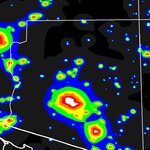Space

For the first time ever, NASA will beam a song -- The Beatles' "Across the Universe" -- directly into deep space at 7 p.m. EST on Feb. 4.
The transmission over NASA's Deep Space Network will commemorate the 40th anniversary of the day The Beatles recorded the song, as well as the 50th anniversary of NASA's founding and the group's beginnings. Two other anniversaries also are being honored: The launch 50 years ago this week of Explorer 1, the first U.S. satellite, and the founding 45 years ago of the Deep Space Network, an international network of antennas that supports missions to explore…

Only 4% of the universe is made of known material - the other 96% is traditionally labelled into two sectors, dark matter and dark energy. Dr HongSheng Zhao at the University of St Andrews believes dark matter and its counterpart dark energy may be more closely linked than was previously thought.
Astronomers believe that both the universe and galaxies are held together by the gravitational attraction of a huge amount of unseen material, first noted by the Swiss astronomer Fritz Zwicky in 1933, and now commonly referred to as dark matter.
Dr Zhao reports that, "Dark energy has already…

Using ESO's Very Large Telescope Interferometer, astronomers have probed the inner parts of the disc of material surrounding a young stellar object, witnessing how it gains its mass before becoming an adult.
The astronomers had a close look at the object known as MWC 147, lying about 2,600 light years away towards the constellation of Monoceros ('the Unicorn'). MWC 147 belongs to the family of Herbig Ae/Be objects. These have a few times the mass of our Sun and are still forming, increasing in mass by swallowing material present in a surrounding disc.
MWC 147 is less than half a million years…

Since the term "black hole" was coined by John Wheeler in 1967, they have been used to resolve a lot of science-fiction plot inconsistencies.
Sometimes they resolve real-life ones too, especially if there is no other explanation.
HE 0437-5439, is an early-type star and one of ten so-called hypervelocity stars that are speeding away from the Milky Way galaxy - because of its young age, astronomers stated it could not have come from our galaxy. Carnegie astronomers Alceste Bonanos and Mercedes López-Morales, and collaborators Ian Hunter and Robert Ryans from Queen’s University Belfast…

The newly discovered asteroid 2007 TU24 is passing within 1.4 lunar distances, or 334,000 miles, of Earth today.
The asteroid, estimated at between 150 and 600 meters in diameter, was discovered by the University of Arizona’s Catalina Sky Survey in October 2007. It poses no threat to Earth, but its near approach gives astronomers a golden opportunity to learn more about potentially hazardous near-Earth objects. And conspiracy theorists a chance to speculate on NASA.
Some people are genuinely concerned about this asteroid causing an End of Life event on Earth. Not to worry. We know how to…

A new report by the Arizona Arts, Sciences, and Technology Academy (AASTA) found that research in astronomy, planetary sciences, and space sciences (APSS) pumped over $250 million into Arizona’s economy in 2006 alone.
That's real money but it's not all balloons and ponies for Arizona. There are threats to that economic engine and it's what you can probably guess - the instability of federal funding and competition from other locations - but it's also things you might not guess, like light pollution from residential and commercial development and lingering memories of environmental and…

ESA’s orbiting gamma-ray observatory, Integral, has made the first unambiguous discovery of highly energetic X-rays coming from a galaxy cluster. The find has shown the cluster to be a giant particle accelerator.
The Ophiuchus galaxy cluster is one of brightest in the sky at X-ray wavelengths. The X-rays detected are too energetic to originate from quiescent hot gas inside the cluster and suggest instead that giant shockwaves must be rippling through the gas. This has turned the galaxy cluster into a giant particle accelerator.
Most of the X-rays come from hot gas in the cluster, which in…

When the Stardust mission returned to Earth with samples from the comet Wild 2 in 2006, scientists knew the material would provide new clues about the formation of our solar system, but they didn’t know exactly how.
Contrary to expectations for a small icy body, much of the comet dust returned by the Stardust mission formed very close to the young sun and was altered from the solar system’s early materials.
New research by scientists at Lawrence Livermore National Laboratory and collaborators reveals that, in addition to containing material that formed very close to the young sun, the dust…

On January 14, 2008, more than three decades after the third Mariner 10 flyby, the last spacecraft visit of Mercury, MESSENGER passed 200 kilometers above Mercury's surface. Extensive scientific observations were executed during this flyby encounter, including imaging a large portion of Mercury's surface that has never before been seen by a spacecraft.

Neutron stars can be considerably more massive than previously believed and it is more difficult to form black holes, according to new research developed by using the Arecibo Observatory in Arecibo, Puerto Rico. Paulo Freire, an astronomer from the observatory, will present his research at the American Astronomical Society national meeting in Austin on Jan. 11.
In the cosmic continuum of dead, remnant stars, the Arecibo astronomers have increased the mass limit for when neutron stars turn into black holes.
“The matter at the center of a neutron star is highly incompressible. Our new…